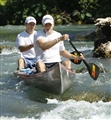How Low Sodium Kills
by Fraser Baker, Ph.D.
News story, June 14th:
| |
 |
| |
Brad Ellis (front) |
"Endurance race claims boater's life" (San Antonio, TX)
"A paddler participating in the Texas Water Safari, an endurance boat race on the San Marcos and Guadalupe rivers, died Monday afternoon at a San Antonio hospital, marking the first fatality in the event's 50-year history...
"Ellis died of hyponatremia, or low sodium, said Allen Spelce, president of the Texas Water Safari. “It goes against logic,” Spelce said. “You think, ‘Drink water, drink water,' but you're expelling all of that sodium, through sweat and using the bathroom, and not getting the replacements...”
Complete story: My San Antonio.com
Brad Ellis, a Texas Water Safari participant collapsed after some 20 hours into the race and died later on due to hyponatremia (low blood sodium). The day was hot and obviously he lost too much sodium through sweat. How does low sodium kill? To understand this, we need to get into some physiology.
Body temperature is regulated by sweating. There are two kinds of sweat … imperceptible and perceptible. Imperceptible sweat is the kind the goes on pretty much all the time, where a small amount of moisture is secreted onto the body’s surface by sweat glands, which in turn cools the body throuh evaporation. When the rate of sweating is low, sweat glands can retain sodium and one’s skin does not normally taste salty. When the rate of sweating is high as occurs when the body is overheating, sweating becomes perceptible and sweat glands cannot retain sodium during high volume sweating and the skin becomes moist and tastes salty.
We must now consider the two major liquid compartments in the body: extracellular (outside cells) and intracellular (inside cells). The largest extracellular volume is in the blood, being some 2.5 liters or 2.65 quarts. Note that blood volume is 5 liters, but half of that volume is composed of cells. Pretty much all of the rest of tissue volume is intracellular volume, which is some 25 liters, some 10 times extracellular volume.
OK, so how does this pertain to how an acute reduction of sodium kills? Unfortunately, we must now consider potassium to understand this. The concentration of sodium and potassium in extracellular fluid is 3.2 and 0.4 while that in intracellular fluid is 0.1 and 6 grams per liter respectively. To reiterate, in extracellular fluid (blood), the concentration of sodium relative to potassium is high whereas in intracellular fluid, the relative concentrations of these two ions are reversed. These rather large concentration gradients are maintained by little ionic pumps in the cell’s membrane.
Active cells, and by this I mean cells that when stimulated do something like contracting (heart and other muscle cells), communicate or remember something (nerve cells), or secrete something (endocrine cells), These actions are a consequence of changes in the relative permeability of the cell membrane to electrolytes, particularly sodium and potassium. Resting cells have a high permeability to sodium and a low permeability to potassium. This condition results in the generation of a voltage of some 75 millivolts, inside negative, caused essentially by the potassium gradient across the cell membrane. One can think of the cell’s membrane being a potassium battery. While 70 millivolts doesn’t sound like much, the gradient is huge, some 7,000 volts per mm as the cell membrane is very thin (10 nanometers).
And this is where the physiology gets interesting. When a cell, capable of doing something when stimulated say to contract, as in the case of a muscle cell, the permeability to potassium precipitously falls momentarily turning the cell membrane into a sodium battery, which drives the transmembrane voltage positive some 15 millivolts. This reversal in membrane potential causes a lot of things to happen inside the cell. In the case of muscle cells the free intracellular calcium ion concentration rises, which in turn causes muscle filaments to ratchet over each other and the muscle cell contracts. The normal sodium to potassium membrane permeabilities recover within a few milliseconds and the cell returns to its resting state, waiting for the next stimulus to occur and another contraction.
So, in simplistic terms an acute reduction in extracellular sodium kills by reducing the size of the membrane potential reversal, which in the extreme case doesn’t reach the trigger point and the muscle cell stops contracting.
As discussed above, the amount of sodium carried in the body is not that great and it is easy to lose a significant amount of it during extreme exercise, which the Texas Water Safari is. Drink water, drink water, so goes the advice reiterated by Allen Spelce, president of the Texas Water Safari, needs to be replaced with an emphasis on drinking sports beverages instead of water, particularly when the potential for sweating is great.
Fraser Baker, Ph.D.
Houston Canoe Club
PS: This discussion is a simplification. While in general, the concepts are correct, details have been glossed over in order to convey some of the magic of life.

|
The author,
Fraser Baker
|